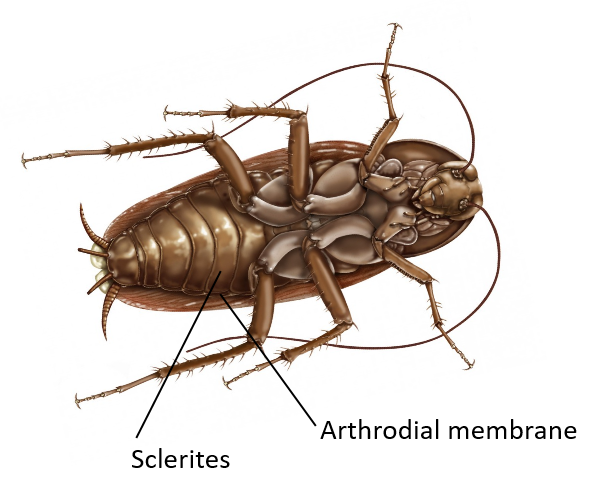
In cockroach sclerites are joined by
(a) Terga
(b) Sterna
(c) Pleura
(d) Arthrodial membrane
Answer
505.5k+ views
Hint: A thin flexible membrane known as the Articular Membrane is fused in cockroach sclerites. The articular membrane is an arthropod specialty. It is a flexible membrane that is, in essence, non-sclerotic and present between the sclerites of the arthropod segmented body.
Complete answer:
The cockroach's whole body is enclosed by a chitinous, rigid exoskeleton. The exoskeleton has hardened plates in each segment, called sclerites, which are joined by a thin and flexible articular membrane known as the arthrodial membrane.

So, the correct answer is, ‘Arthrodial membrane’.
Additional Information:
Sclerite, a hard exoskeleton, brown, is made up of chitin.
In Arthropoda, the hardening that creates sclerites is achieved either by cross-linking protein chains in the exocuticle, a process called sclerotization, or by adding minerals such as calcium carbonate into the exoskeleton regions, or both. The exoskeleton of an arthropod is divided into various sclerites, joined by regions or sutures that are less sclerotic and membranous.
A body section of dorsal sclerites, sometimes platelike, is known as tergites. Equally, a body segment's ventral sclerites are referred to as sternites. Separate sclerites are called pleurites for the lateral parts of body segments, the pleura.
Note: The body is covered/supported by a chitinous exoskeleton in a cockroach, it is secreted by the hypodermis' underlying cells. This exoskeleton is divided into smaller parts called sclerites, connected by a soft and flexible layer called the arthrodial membrane that lacks exocuticle so that the body can move flexibly.
Complete answer:
The cockroach's whole body is enclosed by a chitinous, rigid exoskeleton. The exoskeleton has hardened plates in each segment, called sclerites, which are joined by a thin and flexible articular membrane known as the arthrodial membrane.

So, the correct answer is, ‘Arthrodial membrane’.
Additional Information:
Sclerite, a hard exoskeleton, brown, is made up of chitin.
In Arthropoda, the hardening that creates sclerites is achieved either by cross-linking protein chains in the exocuticle, a process called sclerotization, or by adding minerals such as calcium carbonate into the exoskeleton regions, or both. The exoskeleton of an arthropod is divided into various sclerites, joined by regions or sutures that are less sclerotic and membranous.
A body section of dorsal sclerites, sometimes platelike, is known as tergites. Equally, a body segment's ventral sclerites are referred to as sternites. Separate sclerites are called pleurites for the lateral parts of body segments, the pleura.
Note: The body is covered/supported by a chitinous exoskeleton in a cockroach, it is secreted by the hypodermis' underlying cells. This exoskeleton is divided into smaller parts called sclerites, connected by a soft and flexible layer called the arthrodial membrane that lacks exocuticle so that the body can move flexibly.
Latest Vedantu courses for you
Grade 11 Science PCM | CBSE | SCHOOL | English
CBSE (2025-26)
School Full course for CBSE students
₹41,848 per year
Recently Updated Pages
Master Class 11 Economics: Engaging Questions & Answers for Success

Master Class 11 Business Studies: Engaging Questions & Answers for Success

Master Class 11 Accountancy: Engaging Questions & Answers for Success

Master Class 11 English: Engaging Questions & Answers for Success

Master Class 11 Computer Science: Engaging Questions & Answers for Success

Master Class 11 Maths: Engaging Questions & Answers for Success

Trending doubts
Which one is a true fish A Jellyfish B Starfish C Dogfish class 11 biology CBSE

State and prove Bernoullis theorem class 11 physics CBSE

1 ton equals to A 100 kg B 1000 kg C 10 kg D 10000 class 11 physics CBSE

In which part of the body the blood is purified oxygenation class 11 biology CBSE

One Metric ton is equal to kg A 10000 B 1000 C 100 class 11 physics CBSE

Difference Between Prokaryotic Cells and Eukaryotic Cells




